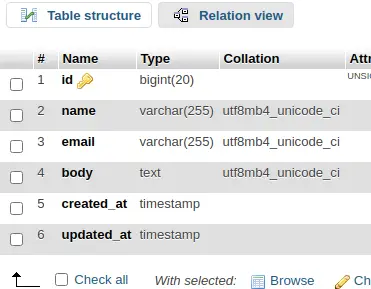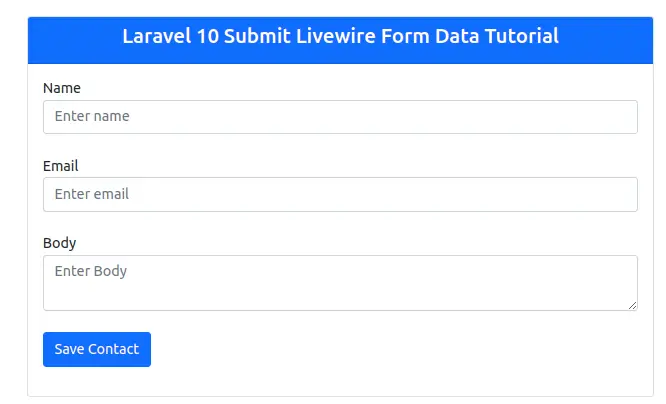Forms are an essential part of web development, and Laravel 10 paired with Livewire makes form submissions a joy. We will walk you through the process of submitting Livewire form data in Laravel 10 in this article.
Livewire is a powerful tool for creating interactive and dynamic components without writing a lot of JavaScript code. We will guide you through the steps of creating Livewire components for forms, handling form submissions, performing server-side validation, and providing real-world examples of how to efficiently use Livewire in your online applications.
Read More: Laravel 10 Livewire Pagination Example Tutorial
Let’s get started.
Laravel Installation
Open terminal and run this command to create a laravel project.
composer create-project laravel/laravel myblogIt will create a project folder with name myblog inside your local system.
To start the development server of laravel –
php artisan serveURL: http://127.0.0.1:8000
Assuming laravel already installed inside your system.
Create Database & Connect
To create a database, either we can create via Manual tool of PhpMyadmin or by means of a mysql command.
CREATE DATABASE laravel_app;
To connect database with application, Open .env file from application root. Search for DB_ and update your details.
DB_CONNECTION=mysql DB_HOST=127.0.0.1 DB_PORT=3306 DB_DATABASE=laravel_app DB_USERNAME=root DB_PASSWORD=root
Create Model & Migration
Open project into terminal.
Let’s create model and migration by using a single command.
Creating model and migration …
$ php artisan make:model Contact -mRead More: Laravel 10 Auth with Livewire Jetstream Tutorial
Above command will create 2 files –
- Model file with name Contact.php inside /app/Models folder.
- Migration File with name 2023_09_02_113017_create_contacts_table.php inside /database/migrations folder.
Open up the migration file and write this complete code,
<?php
use Illuminate\Database\Migrations\Migration;
use Illuminate\Database\Schema\Blueprint;
use Illuminate\Support\Facades\Schema;
return new class extends Migration
{
/**
* Run the migrations.
*/
public function up(): void
{
Schema::create('contacts', function (Blueprint $table) {
$table->id();
$table->string('name');
$table->string('email');
$table->text('body');
$table->timestamps();
});
}
/**
* Reverse the migrations.
*/
public function down(): void
{
Schema::dropIfExists('contacts');
}
};
Open model file Contact.php and write this code into it.
<?php
namespace App\Models;
use Illuminate\Database\Eloquent\Factories\HasFactory;
use Illuminate\Database\Eloquent\Model;
class Contact extends Model
{
use HasFactory;
protected $fillable = [
'name', 'email', 'body'
];
}
Run Migration
Back to terminal and run this command to run migration file.
$ php artisan migrateIt will run all pending migrations of your application. contacts table will be created.

Livewire Installation (Composer Package)
Back to project terminal and run this command to install livewire inside application,
$ composer require livewire/livewireTerminal shell be like,

Now, you are able to use the features and functions of livewire.
Next,
Generate Livewire Scaffold Files
Back to terminal and run this command to create livewire folder & files.
$ php artisan make:livewire contact-formRead More: Laravel 10 API Testing Tool Package Tutorial
Above command will create these files –
- ContactForm.php file inside /app/Livewire folder.
- contact-form.blade.php file inside /resources/views/livewire
Open ContactForm.php and write this following code into it.
<?php
namespace App\Livewire;
use Livewire\Component;
use App\Models\Contact;
class ContactForm extends Component
{
public $name;
public $email;
public $body;
public function submit()
{
$validatedData = $this->validate([
'name' => 'required|min:6',
'email' => 'required|email',
'body' => 'required',
]);
Contact::create($validatedData);
return redirect()->to('contact-form');
}
public function render()
{
return view('livewire.contact-form');
}
}
Open contact-form.blade.php and write this following code into it.
<div>
<form wire:submit.prevent="submit">
<div class="form-group">
<label for="exampleInputName">Name</label>
<input type="text" class="form-control" id="exampleInputName" placeholder="Enter name" wire:model="name">
@error('name') <span class="text-danger">{{ $message }}</span> @enderror
</div>
<br />
<div class="form-group">
<label for="exampleInputEmail">Email</label>
<input type="text" class="form-control" id="exampleInputEmail" placeholder="Enter email" wire:model="email">
@error('email') <span class="text-danger">{{ $message }}</span> @enderror
</div>
<br />
<div class="form-group">
<label for="exampleInputbody">Body</label>
<textarea class="form-control" id="exampleInputbody" placeholder="Enter Body" wire:model="body"></textarea>
@error('body') <span class="text-danger">{{ $message }}</span> @enderror
</div>
<br />
<button type="submit" class="btn btn-primary">Save Contact</button>
</form>
</div>Setup Blade Template File
Create a blade template file form.blade.php inside /resources/views folder.
Open form.blade.php and write this following code into it.
<html>
<head>
<title>Laravel 10 Submit Livewire Form Data Tutorial</title>
<link rel="stylesheet" href="https://cdnjs.cloudflare.com/ajax/libs/font-awesome/4.7.0/css/font-awesome.min.css">
<link href="https://cdn.jsdelivr.net/npm/bootstrap@5.0.2/dist/css/bootstrap.min.css" rel="stylesheet" />
<script src="https://cdnjs.cloudflare.com/ajax/libs/jquery/3.6.0/jquery.min.js"></script>
@livewireStyles
</head>
<body>
<div class="container mt-4">
<div class="card">
<div class="card-header text-center text-white bg-primary">
<h4 class="text-center">Laravel 10 Submit Livewire Form Data Tutorial</h4>
</div>
<div class="card-body">
@livewire('contact-form')
</div>
</div>
</div>
<script src="{{ asset('js/app.js') }}"></script>
@livewireScripts
</body>
</html>Add Route
Open web.php file from /routes folder. Add this route into it.
//...
Route::get('contact-form', function () {
return view('form');
});
//...
Application Testing
Run this command into project terminal to start development server,
php artisan serveURL: http://127.0.0.1:8000/contact-form

Read More: Laravel 10 How To Get Logged In User Data Tutorial
After form data save, you will get records inside your contacts table.

We hope this article helped you to learn about Laravel 10 Submit Livewire Form Data Tutorial in a very detailed way.
If you liked this article, then please subscribe to our YouTube Channel for PHP & it’s framework, WordPress, Node Js video tutorials. You can also find us on Twitter and Facebook.
Read more